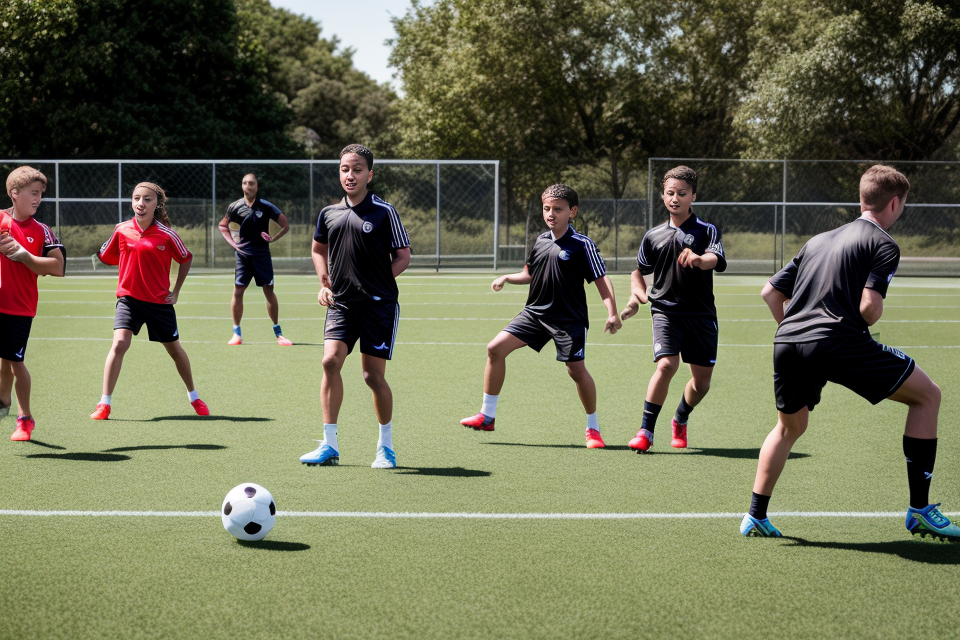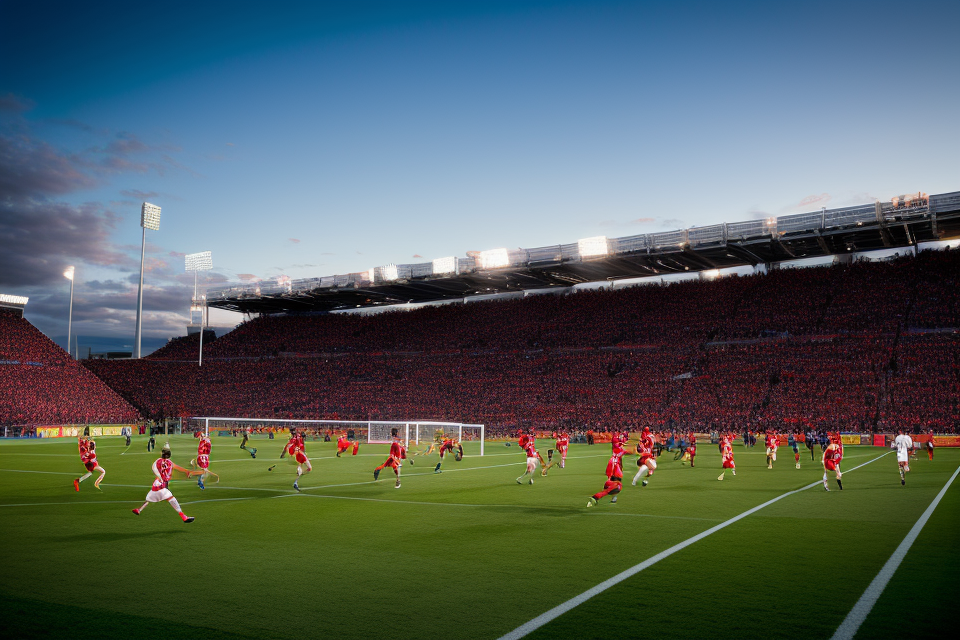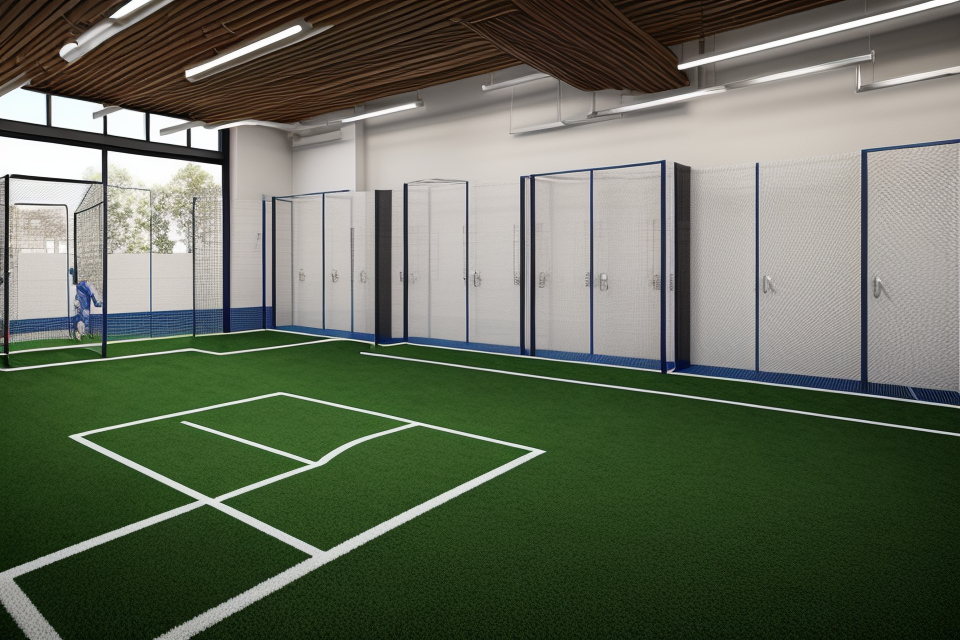Soccer is a sport that requires a great deal of physical and mental preparation to achieve optimal performance on the field. To be a successful soccer player, one must train both their body and mind to work together in harmony. The training program should be tailored to the individual’s needs, taking into account their strengths, weaknesses, and goals. In this article, we will explore the various aspects of soccer training, including physical conditioning, technical skills, tactical knowledge, and mental preparation. We will also discuss the importance of a well-rounded training program and provide tips for creating an effective training schedule. Whether you’re a beginner or a seasoned pro, this guide will help you to achieve your full potential on the soccer field.
To train for optimal performance in soccer, a player should focus on a combination of strength and endurance training, as well as technical drills specific to their position on the field. This should include a mix of both high-intensity and low-intensity exercises, as well as adequate rest and recovery time. Additionally, it is important for a soccer player to maintain a healthy diet and stay hydrated in order to support their physical performance. Finally, mental preparation and visualization techniques can also be helpful in achieving optimal performance on the field.
Understanding the Importance of Proper Training
Benefits of Proper Training for Soccer Players
Proper training is crucial for soccer players to achieve optimal performance on the field. It helps them to develop their physical, technical, mental, and tactical abilities, which are essential for success in the sport. Here are some of the benefits of proper training for soccer players:
Improved Physical Conditioning
Physical conditioning is a vital aspect of soccer training. It involves improving the player’s strength, endurance, speed, agility, and flexibility. Proper training helps players to build up their physical fitness, which is necessary for them to perform at their best during matches. For instance, interval training, which involves short bursts of intense exercise followed by periods of rest, can help soccer players to improve their cardiovascular endurance and increase their speed and agility.
Enhanced Technical Skills
Technical skills are the fundamental skills required for playing soccer. These skills include dribbling, passing, shooting, and ball control. Proper training helps players to enhance their technical skills through repetition and practice. For example, players can work on their ball control by performing exercises that involve using different parts of their feet to control the ball.
Increased Mental Toughness
Mental toughness is an essential trait for soccer players. It involves having the ability to cope with pressure, maintain focus, and stay positive under challenging situations. Proper training helps players to develop their mental toughness by teaching them techniques for managing stress and anxiety, visualizing success, and building confidence. For instance, mental conditioning exercises such as visualization and positive self-talk can help players to build their mental resilience and stay focused during matches.
Reduced Risk of Injury
Injuries are a common occurrence in soccer, and they can be caused by various factors such as poor technique, lack of fitness, and insufficient warm-up. Proper training helps players to reduce their risk of injury by teaching them proper techniques for tackling, jumping, and landing. Additionally, players can incorporate injury prevention exercises into their training routine, such as stretching and strengthening exercises, to help maintain their fitness and reduce their risk of injury.
Common Training Mistakes to Avoid
Overemphasis on Aerobic Exercise
One common mistake soccer players make when training is an overemphasis on aerobic exercise. While endurance is important for soccer performance, it is not the only factor. Soccer is a sport that requires a combination of endurance, strength, power, and speed. Therefore, a well-rounded training program should include a mix of both aerobic and anaerobic exercises.
Neglecting Strength and Conditioning
Another common mistake is neglecting strength and conditioning exercises. Soccer players need to have strong muscles in their legs, core, and upper body to perform at their best. Neglecting these exercises can lead to muscle imbalances and increase the risk of injury. A comprehensive strength and conditioning program should be incorporated into the training regimen to ensure optimal performance.
Inadequate Recovery Time
Inadequate recovery time is another mistake that soccer players often make. Recovery time is crucial for muscle growth and repair. Without enough rest, the body cannot fully recover from training sessions, which can lead to fatigue, decreased performance, and increased risk of injury. Soccer players should allow for sufficient recovery time between training sessions and games to ensure optimal performance.
Failure to Focus on Weaknesses
Lastly, soccer players should avoid the mistake of focusing only on their strengths during training. While it is important to build on strengths, it is equally important to address weaknesses. Identifying and working on areas that need improvement can help soccer players become more well-rounded and improve their overall performance. A tailored training program that addresses individual weaknesses can help soccer players reach their full potential.
Developing a Comprehensive Training Program
Assessing Your Current Fitness Level
To achieve optimal performance as a soccer player, it is essential to have a comprehensive training program that caters to your individual needs. The first step in creating such a program is to assess your current fitness level. This assessment will help you identify areas that need improvement and develop a tailored training plan that targets those areas. Here are some ways to assess your current fitness level:
- Conducting a Fitness Test
A fitness test is a standardized assessment that measures various aspects of physical fitness, such as endurance, strength, and speed. The most common fitness tests for soccer players include the beep test, the Yo-Yo test, and the shuttle run. These tests are designed to simulate the demands of soccer and provide a baseline measurement of your fitness level. - Analyzing Results and Identifying Areas for Improvement
Once you have conducted a fitness test, it is crucial to analyze the results and identify areas for improvement. A comprehensive analysis should include:- Cardiovascular endurance: This refers to the ability of your heart, lungs, and blood vessels to supply oxygen to your muscles during exercise. Poor cardiovascular endurance can limit your performance during high-intensity soccer matches.
- Muscular strength and endurance: This refers to the strength and endurance of your muscles. Soccer players require muscular strength and endurance in their legs, core, and upper body to perform various movements on the field.
- Speed and agility: This refers to your ability to move quickly and change direction rapidly. Soccer players need to be fast and agile to evade opponents and make quick decisions on the field.
- Flexibility and mobility: This refers to the range of motion of your joints and muscles. Good flexibility and mobility can help prevent injuries and improve your overall performance.
Based on your fitness test results, you can identify areas that need improvement and develop a training program that targets those areas. For example, if your cardiovascular endurance is low, you may need to include more high-intensity interval training in your program. If your muscular strength and endurance is lacking, you may need to incorporate more strength training exercises into your routine. By analyzing your fitness test results and tailoring your training program accordingly, you can optimize your performance as a soccer player.
Setting Goals and Developing a Plan
When it comes to developing a comprehensive training program for soccer, setting goals and developing a plan are crucial steps that can help guide a player towards optimal performance. By identifying short-term and long-term goals, creating a customized training program, and scheduling and tracking progress, soccer players can set themselves up for success both on and off the field.
Identifying Short-Term and Long-Term Goals
Before starting any training program, it’s important for soccer players to identify both short-term and long-term goals. Short-term goals may include improving ball control, increasing speed and agility, or perfecting a specific move or technique. Long-term goals may include becoming a starter on the team, earning a college scholarship, or making it to the professional level.
Having clear and specific goals in mind can help motivate and focus a player’s training, as well as provide a sense of direction and purpose. It’s important to make sure that goals are achievable and realistic, but also challenging enough to push the player to improve.
Creating a Customized Training Program
Once goals have been identified, the next step is to create a customized training program that is tailored to the player’s individual needs and goals. This may involve working with a coach or trainer to develop a training schedule that includes a variety of exercises and drills, such as strength and conditioning, agility and footwork drills, and ball control exercises.
It’s important to remember that everyone is different, and what works for one player may not work for another. For example, a player who is looking to improve their speed and endurance may benefit from interval training, while a player who is looking to improve their ball control may benefit from more technical drills.
Scheduling and Tracking Progress
In order to see progress and achieve goals, it’s important to schedule and track progress regularly. This may involve keeping a training log or journal, tracking measurements such as weight and height, or using performance metrics such as speed and agility testing.
Regular tracking can help a player stay motivated and accountable, as well as provide a sense of progress and accomplishment. It’s important to set realistic expectations and not get discouraged if progress is not immediate. Consistency and persistence are key to achieving long-term goals.
In conclusion, setting goals and developing a plan are crucial steps in developing a comprehensive training program for soccer players. By identifying short-term and long-term goals, creating a customized training program, and scheduling and tracking progress, players can set themselves up for success both on and off the field.
Incorporating Different Types of Training
To achieve optimal performance on the soccer field, it is essential to incorporate a variety of training methods into a comprehensive program. By including different types of training, a player can improve their overall fitness, strength, agility, and coordination. Here are some key types of training that soccer players should consider incorporating into their routine:
- Aerobic Exercise: Aerobic exercise is an excellent way to improve cardiovascular fitness, which is essential for soccer players. Running, cycling, and swimming are all great ways to improve cardiovascular health. Aerobic exercise can also help players maintain a healthy body weight and reduce the risk of injury.
- Strength and Conditioning: Strength and conditioning exercises are designed to improve muscular strength and endurance. This type of training is particularly important for soccer players, as it helps them maintain control of the ball and maintain their balance while moving at high speeds. Strength and conditioning exercises can include weightlifting, resistance training, and bodyweight exercises like push-ups and squats.
- Plyometrics and Jump Training: Plyometrics are explosive exercises that are designed to improve power and speed. Jump training is a type of plyometric exercise that is particularly effective for soccer players. By incorporating plyometrics and jump training into their routine, players can improve their vertical jump, which is essential for heading the ball and making successful tackles.
- Agility and Speed Training: Agility and speed training are designed to improve a player’s ability to change direction quickly and move at high speeds. This type of training can include drills like shuffle drills, ladder drills, and cone drills. By improving their agility and speed, players can improve their ability to evade opponents and make successful tackles.
- Balance and Coordination Training: Balance and coordination training are designed to improve a player’s ability to maintain their balance while moving at high speeds. This type of training can include exercises like single-leg squats, single-leg deadlifts, and single-leg bounds. By improving their balance and coordination, players can improve their ability to maintain control of the ball and avoid slips and falls.
Incorporating these different types of training into a comprehensive training program can help soccer players achieve optimal performance on the field. By working with a personal trainer or fitness coach, players can develop a customized training program that meets their individual needs and goals.
Periodization and Recovery
In order to achieve optimal performance on the soccer field, it is essential for players to develop a comprehensive training program that incorporates periodization and recovery strategies. Periodization refers to the systematic organization of training into different phases or cycles, each with a specific focus and goal. Recovery, on the other hand, involves allowing the body to rest and repair itself after intense training sessions.
Here are some key elements of periodization and recovery that soccer players should consider when developing their training program:
Planning Training Cycles
Training cycles should be designed to progressively increase in intensity and difficulty over time. For example, a player might begin with a phase focused on building endurance and strength, followed by a phase focused on developing speed and agility, and finally a phase focused on fine-tuning technical skills and tactical knowledge.
Incorporating Rest and Recovery Days
Rest and recovery days are crucial for allowing the body to repair and rebuild muscle tissue, reduce muscle soreness, and prevent injury. Soccer players should aim to incorporate at least one rest day per week, as well as incorporate active recovery techniques such as stretching, foam rolling, and light exercise to help speed up the recovery process.
Incorporating Active Recovery Techniques
Active recovery techniques involve low-intensity exercise that helps to reduce muscle soreness and prevent injury. These might include light jogging, yoga, or swimming. By incorporating active recovery techniques into their training program, soccer players can help to improve their overall performance and reduce their risk of injury.
In summary, periodization and recovery are essential components of a comprehensive training program for soccer players. By systematically organizing training into different phases, incorporating rest and recovery days, and incorporating active recovery techniques, players can improve their performance on the field and reduce their risk of injury.
Implementing the Training Program
Nutrition and Hydration
- Fueling for Optimal Performance
- Hydration Strategies for Soccer Players
Fueling for Optimal Performance
Proper nutrition is essential for a soccer player to maintain energy levels, support muscle growth and repair, and promote overall health. Here are some key points to consider when developing a nutrition plan:
- Carbohydrates: These are the primary source of fuel for soccer players, providing energy for high-intensity efforts on the field. Foods such as whole grains, fruits, and vegetables should make up the majority of a player’s diet.
- Protein: Crucial for muscle growth and repair, protein can be found in foods like lean meats, dairy products, and plant-based sources like beans and nuts. It’s important to strike a balance between protein intake and overall calorie consumption.
- Healthy Fats: These are vital for maintaining healthy cell function and supporting the absorption of certain vitamins and minerals. Good sources of healthy fats include avocados, nuts, and olive oil.
- Vitamins and Minerals: Adequate intake of vitamins and minerals is essential for optimal performance, as they support various bodily functions such as energy production, bone health, and immune function. Foods like dark leafy greens, citrus fruits, and berries are rich in vitamins and minerals.
It’s also important to consider the timing and frequency of meals, ensuring that players consume enough energy to support their training and competition needs. This may involve consuming smaller, more frequent meals throughout the day, or strategically timing larger meals around training sessions.
Hydration Strategies for Soccer Players
Proper hydration is crucial for maintaining physical performance, endurance, and overall health during soccer training and competition. Here are some tips for effective hydration:
- Staying Hydrated Before Training: Players should aim to drink plenty of water in the hours leading up to training, with at least 500-750 ml consumed two to three hours before exercise. This helps to ensure that they begin training adequately hydrated.
- Drinking During Training: Soccer players should drink water frequently during training breaks, with each break lasting at least ten minutes. This helps to maintain hydration levels and supports optimal performance.
- Post-Exercise Hydration: After training, it’s important to replenish fluids and electrolytes lost through sweat. Players should aim to consume 500-750 ml of water or a sports drink containing electrolytes within the first 30 minutes after exercise.
- Hydration Strategies for Match Days: On match days, players should follow similar hydration guidelines as for training, ensuring that they stay adequately hydrated before and during the game. Additionally, they should consume a small amount of carbohydrates (e.g., a banana or energy gel) about an hour before kickoff to provide a quick energy boost.
By focusing on proper nutrition and hydration, soccer players can support their physical performance, optimize their health, and reduce the risk of injury.
Mental Preparation
A soccer player’s performance on the field is heavily influenced by their mental state. Mental preparation is crucial for optimal performance, as it helps players develop the focus, confidence, and resilience needed to succeed. Here are some key elements of mental preparation for soccer players:
Developing a Pre-Game Routine
Developing a pre-game routine can help players feel more in control and reduce pre-game anxiety. A pre-game routine might include stretching, visualization, or other activities that help players get into the right mindset. The routine should be tailored to the individual player’s needs and preferences, but it should be consistent to help establish a sense of predictability and control.
Visualization Techniques
Visualization techniques involve mentally rehearsing specific aspects of the game, such as making a key pass or scoring a goal. By mentally rehearsing these actions, players can improve their muscle memory and increase their confidence on the field. Visualization can also help players deal with anxiety and stress by providing a sense of control over their emotions.
Building Confidence and Reducing Anxiety
Confidence and anxiety are closely linked in sports performance. Players who are confident are more likely to perform well, while those who are anxious may struggle to perform at their best. To build confidence, players can set achievable goals, focus on their strengths, and receive positive feedback from coaches and teammates. To reduce anxiety, players can use relaxation techniques, such as deep breathing or progressive muscle relaxation, to calm their minds and bodies before a game.
Monitoring Progress and Making Adjustments
Keeping a Training Log
Keeping a training log is an essential part of monitoring progress and making adjustments to the training program. A training log allows the soccer player to track their progress, identify patterns, and make necessary changes to their training regimen. It is recommended that soccer players keep a record of their training sessions, including the exercises performed, the number of repetitions, sets, and rest periods. Additionally, they should note down any injuries or discomfort experienced during training.
Evaluating Progress and Identifying Areas for Improvement
Evaluating progress and identifying areas for improvement is crucial for optimizing performance. Soccer players should assess their performance regularly and seek feedback from coaches, teammates, and opponents. They should pay attention to their strengths and weaknesses and focus on improving their weaker areas. Regular evaluation can help players identify patterns in their performance and make necessary adjustments to their training program.
Making Adjustments to the Training Program as Needed
Making adjustments to the training program as needed is an essential part of optimizing performance. Soccer players should be flexible and willing to make changes to their training program based on their progress and performance. If a particular exercise or drill is not yielding the desired results, it should be modified or replaced with another exercise that targets the same muscle group or skill. Additionally, if a player experiences an injury or discomfort, they should modify their training program to avoid aggravating the injury.
In summary, monitoring progress and making adjustments to the training program are crucial for optimizing performance in soccer. Soccer players should keep a training log, evaluate their progress regularly, and make necessary adjustments to their training program based on their performance. By doing so, they can achieve optimal performance on the field.
Staying Motivated and Overcoming Obstacles
Setting Realistic Expectations
As a soccer player, it is important to set realistic expectations for yourself in terms of improvement and performance. It is crucial to understand that progress takes time and that setbacks are a natural part of the learning process. Setting achievable goals for yourself can help you stay motivated and focused on your long-term objectives.
Surrounding Yourself with Positive Influences
Having a supportive network of coaches, teammates, and friends can play a significant role in maintaining motivation and overcoming obstacles. Surrounding yourself with positive influences who share your passion for the sport and are invested in your success can help you stay accountable and driven to achieve your goals.
Staying Focused on Long-Term Goals
It is easy to get discouraged when faced with obstacles and setbacks during the training process. However, it is important to maintain a long-term perspective and focus on the bigger picture. By keeping your eye on the ultimate goal, you can stay motivated and continue to work towards improvement, even when faced with challenges along the way.
Additionally, incorporating rest and recovery into your training program is crucial for preventing burnout and reducing the risk of injury. Ensuring that you are properly fueling your body with a balanced diet and staying hydrated can also contribute to overall performance and motivation.
By setting realistic expectations, surrounding yourself with positive influences, and staying focused on long-term goals, a soccer player can maintain motivation and overcome obstacles on the path to optimal performance.
FAQs
1. How many hours should a soccer player train per week?
The amount of training time required for a soccer player can vary depending on their level of play and individual goals. However, as a general guideline, it is recommended that soccer players train for at least 2-3 hours per day, at least 5 days a week. This can include a combination of strength and conditioning, technical skills training, and game simulation drills.
2. What type of training is most effective for improving soccer performance?
There are several types of training that can be effective for improving soccer performance, including strength and conditioning, technical skills training, and game simulation drills. Strength and conditioning can help improve physical attributes such as speed, agility, and endurance, while technical skills training can help improve dribbling, passing, and shooting. Game simulation drills can help players prepare for actual match conditions and improve their decision-making and strategic skills.
3. How important is rest and recovery for a soccer player?
Rest and recovery is crucial for soccer players to avoid injury and improve performance. It is recommended that soccer players take at least one full rest day per week, in addition to regular periods of rest and recovery during training sessions. This can include activities such as stretching, foam rolling, and massage to help reduce muscle soreness and improve mobility.
4. What should a soccer player eat to optimize their training and performance?
Eating a balanced diet that includes a variety of nutrients can help optimize a soccer player’s training and performance. This can include foods such as lean protein, whole grains, fruits, and vegetables. It is also important for soccer players to stay hydrated by drinking plenty of water throughout the day, especially before and during training sessions.
5. How can a soccer player prevent injuries during training?
Preventing injuries during training requires a combination of proper technique, strength and conditioning, and adequate rest and recovery. It is important for soccer players to use proper form and technique during all training exercises, and to gradually increase the intensity and difficulty of exercises over time. Strength and conditioning exercises can also help improve overall muscle strength and stability, which can help prevent injuries. Finally, taking regular rest and recovery periods can help reduce the risk of overuse injuries.



